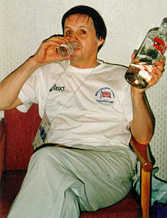Paul Barnes
Professor in Applied Crystallography
E-mail:
p.barnes@mail.cryst.bbk.ac.uk
Direct Telephone: London (020)-7631-6817
FAX: London (020)-7631-6803
Departmental Secretary: London (020)-7631-6800
College Telephone: London (020)-7631-6000
(UK international code is 44)

Here is an untypical picture of me in 1995;
I am almost teetotal, but found a rare excuse here to celebrate!
Brief Academic CV
1963: BSc (Physics, Bristol University)
1967: PhD (Physics & Chemistry of Solids, Cambridge University)
1971: Appointed lecturer in Crystallography, Birkbeck College,
London University.
1994: DSc (Applied Crystallography, London University)
1994: Appointed to personal chair in Applied Crystallography,
London University.
Currently:
Dean of Birkbeck College,
Deputy Head of Department,
Governor of Birkbeck College,
Lecturer on the advanced certificate course Powder Diffraction
on the Web,
Lecturer on the MSc course Molecular Modelling and Bioinformatics,
Council Member of the BCA (British Crystallography Association).
Scientific Interests
I call myself an applied crystallographer which means almost
anything. My interests are X-ray and neutron diffraction (especially
fast in-situ powder diffraction with synchrotron/neutron sources),
computer simulation and a bit of electron microscopy;
all applied to materials like zeolites, ceramics, cements,
hydrates, particularly those with an industrial application.
Recent Research Highlights
-
Simulation of Water and Hydrates
this work started with one of the first
attempts to write an algorithm in which each particle is dynamically and
individually polarised through the ionic/dipolar/quadrupolar/octapolar field of
its environment, and was applied
(see Ref. 1 and
illustration)
to many fundamental properties of
water
and ice structure. These days the applications are more to inorganic
hydrate systems
(see topic 5).
-
Synthesis and Structure of Ultramarine or
Goodbye Lowenstein
Our first real attempt to follow complex solid state high temperature syntheses
(see Ref. 2)
using in-situ time-resolved diffraction: The biggest surprise was that neutron
diffraction and magic angle NMR both confirmed
(see Ref. 2)
that the Al,Si-ordering was random in striking contrast to the
Lowenstein rule applied to an
aluminosilicate with equal numbers of aluminiums and silicons.
-
Polytypism and One-dimensional Disorder in Silicon Carbide
Using a unique batch of large vapour-grown silicon carbide crystals,
this has been studied in SiC by synchrotron X-ray topography
(see Ref. 3)
giving detailed spatial information on the phenomenon.
A new variant, synchrotron edge-topography, illustrated with one
example here,
has been pioneered which provides
depth-profiles
on >100 crystals and a unique database of nearest neighbour
relationships for polytypism and thin one-dimensionally disordered layers.
-
Synthesis of Tetragonal/Monoclinic Zirconia
This project was fuelled by
interest in zirconia-based high performance ceramics and sponsored by Alcan
Chemicals/MEL Co. In-situ studies
(see Ref. 4)
using X-ray diffraction
(see illustration),
Zr-EXAFS and neutron scattering, on the synthesis (from initial
compounds or amorphous hydroxides) have provided a structural model of how
the nuclei evolve during calcination. Also the complex relationship between the
all important tetragonal to monoclinic transformation and synthesis parameters
(heating/cooling rate, top temperature, heating time, initial pH) have been
determined.
-
The double cation valve in Ca/K-clinoptilolite-zeolite
This project was sponsored by British Gas as part of a general study
into the use of zeolites to
separate impurities from natural gas.
The partial ion-exchange of Ca2+ by K+
cations in clinoptilolite was chosen as a prototype project for study by
synchrotron EXAFS and diffraction data but also, crucially, combined with
computer-simulation as well. A new simulation exchange-annealing schedule
has revealed an intriguing sequence in which the Ca-cations are hydrated away
from the framework well into the main channel, exchanged by the K-cations
which are then guided by the water molecules
towards
their future sites which
project more and more from each side of the main channel as the water
molecules are removed. The resulting constriction to the flow of gas molecules
has been termed a
double cation valve and is illustrated in the
schematic.
This forms part of an ongoing study
(see Ref. 5)
into the synthesis and behaviour of functional zeolites.
-
In-situ studies on the hydration of cements
Our understanding of the behaviour and mechanisms of cement hydration
has been transformed
(see Ref. 6)
by means of fast in-situ diffraction studies on bulk cement hydrating systems,
using synchrotron energy-dispersive and neutron diffraction.
The temperature-product scenario for Portland cements
up to 190°C, with and without autoclave
conditions, has been resolved
(see Ref. 6a-f)
a fleeting (50 - 200 seconds) intermediate in the rapid hydration of
tricalcium aluminate has been captured
(see Ref. 6g)
using the ESRF-synchrotron
(see illustration);
the time-dependent solid solution changes during the
formation of ettringite (a calcium sulpho-aluminate hydrate) have been
measured and explained
(see Ref. 6h)
and the high temperature conversion of calcium
aluminate (high alumina) cements has been elucidated
(see Ref. 6i,j),
again involving the
temporary appearance of an intermediate hydrate.
The work is sponsored by several companies, notably Schlumberger C.R.Ltd.,
Castle Cement, and Cementa AB.
-
In-situ studies on the synthesis of zeolites
It is our belief that we conducted the first in-situ diffraction studies
on the hydrothermal synthesis of zeolites using either neutron
or synchrotron sources
(see Ref. 7).
This has been particularly useful in the case of synthesis
under autoclave conditions where conventional analysis, involving
"before and after" methods, gives misleading results.
-
And many more ......
Basically if it diffracts, we'll try to look at it; if it
doesn't diffract we might even still look at it.
Our mission is to understand the
structure and kinetics of functional materials;
how they behave during synthesis or during performance.
So if the price is right we'll look at anything.
In our time we have occasion to also study for example bulk rock analysis
(see Fig. and
Ref. 8a-b),
drug polymorphism
(see Ref. 8c-d),
rubber-based materials
(see Ref. 8e),
micro-mechanical structures
(see Figure and
Ref. 8f),
We are concerned with the general application
(see Ref. 8f-l)
of all applied crystallography techniques to modern materials.
Back to
Industrial Materials Group Homepage
